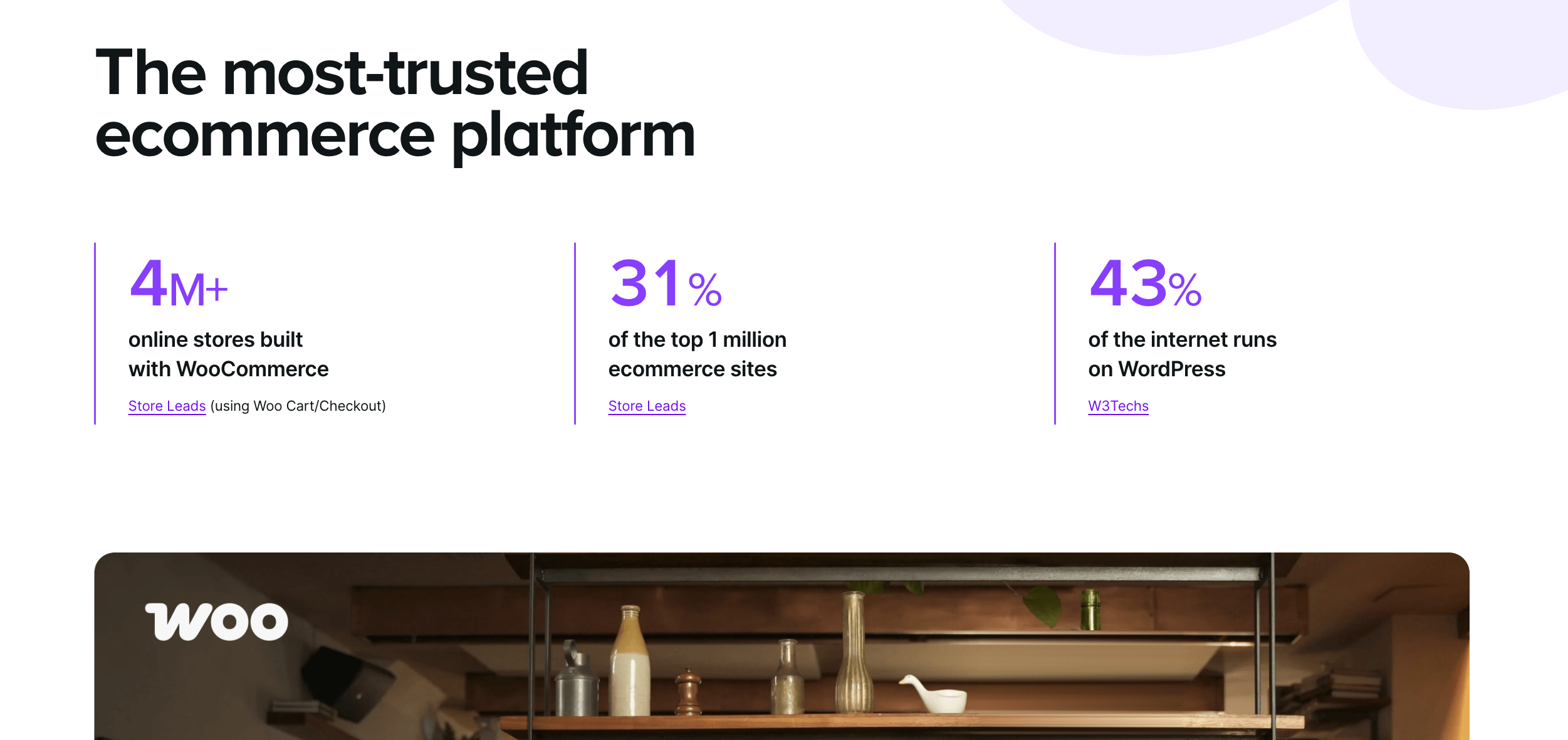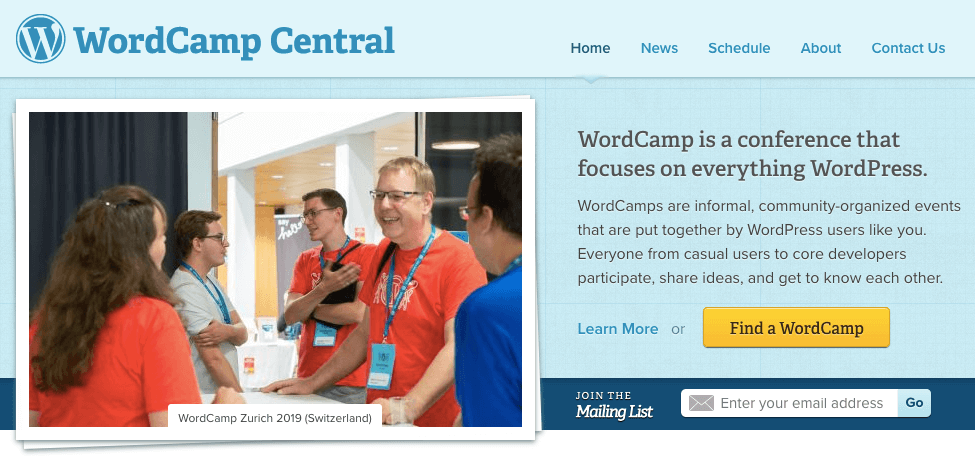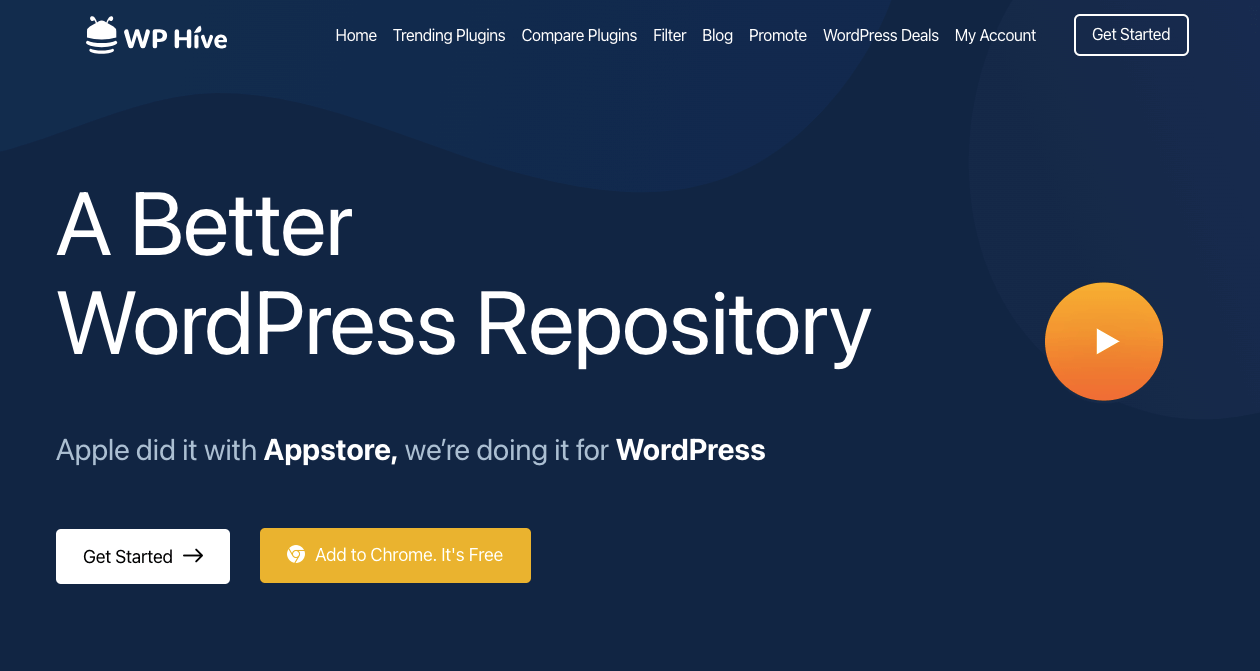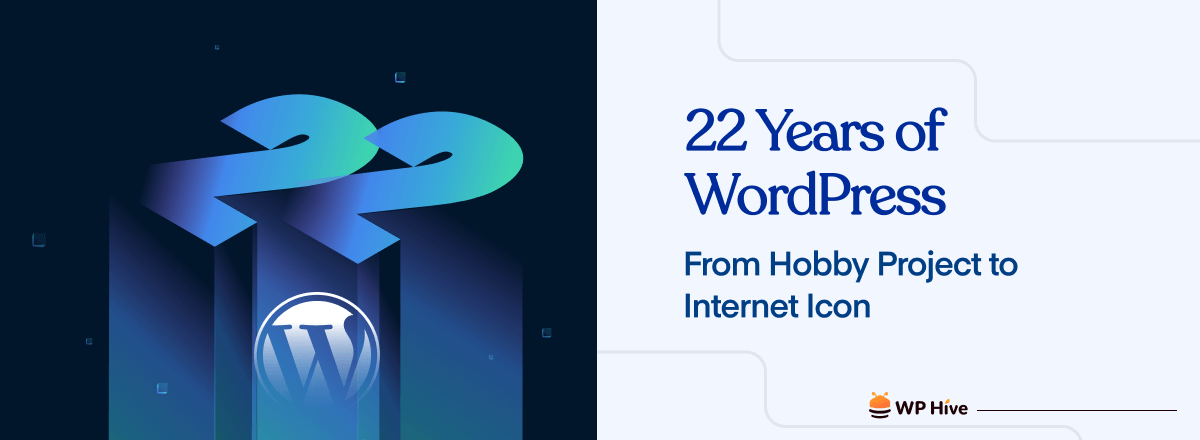May 27, 2003. That’s the day it all began. A fork, a vision, and a bit of stubbornness sparked something that would outgrow every expectation. Fast forward to today – WordPress is turning 22.
Yes, it’s been more than two decades since this open-source project stepped into the world. What started as a simple tool for blogging is now the backbone of over 40% of all websites on the internet.
It’s not just another CMS. It’s a global movement. A platform that gave people, like you and me, a voice online. No gatekeepers. No restrictions. Just the freedom to create.
So, on this birthday, we’re not just lighting candles. We’re celebrating the developers, designers, writers, dreamers, doers, and everyone who made WordPress what it is today.
Back in 2003: How Two Developers Started a Global Movement
Let’s rewind. The internet was still wild. Social media wasn’t a thing. Blogs were raw, personal, and stitched together with complex tools. One of those tools, b2/cafelog, had a loyal user base, but it was abandoned.
Matt Mullenweg was just a college student who liked blogging. When b2 went silent, he didn’t wait around. He took the codebase, teamed up with Mike Little, and started building something new.

That “something” became WordPress.
No funding. No big team. Just two people who believed the internet should be open, and that publishing online should be easy.
And just like that, the first version of WordPress was born. It had a clean admin panel, easy installation, and a promise: anyone could start a blog without knowing how to code.
From Blogs to the Backbone of the Web: WordPress Evolves
WordPress didn’t stay a blogging tool for long. Once the community got involved, the platform started growing like crazy. Plugins rolled in. Themes changed the game. Developers began using it not just for blogs, but for portfolios, forums, shops, directories, and full-on business sites.
Then came 2010. That’s when Custom Post Types entered the scene. With that single update, WordPress stopped being just a “blog engine” and became a real content management system.
You could build anything products, events, recipes, reviews, courses, real estate listings whatever your site needed. The ecosystem exploded.
Then came WooCommerce, and boom, WordPress wasn’t just powering content. It was running full-scale online stores. Today, WooCommerce powers over 30% of all online shops. That’s massive.

Later, the REST API opened the door for headless setups. You could use WordPress as a backend and build the front however you liked with React, Vue, or whatever you’re into.
What started as a tiny blogging tool is now the most-used CMS in the world. It runs personal blogs, government portals, news sites, SaaS platforms, and billion-dollar eCommerce stores. That’s not evolution. That’s a revolution.
Freelancers built businesses around WordPress. Agencies built their services on it. Entire companies were born just to sell WordPress plugins and themes.
And of course, Gutenberg changed everything again. The block editor shifted the editing experience from “old-school text box” to a more visual, drag-and-drop builder. It wasn’t perfect at first, but it pushed WordPress into modern territory.
Note: We explored each major milestone in the WordPress ecosystem later in this article. Keep reading to discover them.
By the Numbers: The State of WordPress in 2025
WordPress isn’t just surviving; it’s leading the internet sphere. As of May 2025, it powers approximately 43% of all websites on the internet, solidifying its position as the most widely used content management system globally.
WordPress is the leading content management system (CMS) with a 62.8% share of the CMS market. From personal blogs to global enterprises like BBC, TechCrunch, Vogue, The New York Times, Spotify, and The White House, WordPress’s versatility and powerful ecosystem have made it an internet icon.
Here’s a snapshot of WordPress’s impressive ecosystem:
- Plugins: Over 60,000 free plugins are available in the official WordPress Plugin Repository, with an estimated 30,000 premium plugins offered by various marketplaces and independent developers.
- Themes: There are more than 31,000 themes, including both free and premium options, allowing users to customize their websites extensively.
- Global Reach: WordPress is used in over 178 countries, with the United States leading at 3.7 million active WordPress sites, followed by Germany (1.7 million) and the United Kingdom (1.3 million).
- Community Contributions: The WordPress community is vibrant and active, with contributors from at least 31 countries participating in core development as of March 2025. (Make WordPress)
- Community Engagement: Over 1,200 WordCamps have been held across 395 cities in 65 countries.
These numbers reflect WordPress’s growing presence in the digital landscape. Its adaptability and the strength of its community continue to drive its success.
Built by Everyone: How the Community Keeps WordPress Alive
WordPress isn’t just software. It’s people. It’s the world’s largest open-source family, spread across continents, cultures, and time zones.
Unlike most tech platforms, WordPress isn’t run by a corporation. It’s fueled by volunteers. Developers write code, designers polish interfaces, translators make it speak every language under the sun. Writers improve docs, and support folks answer questions for free. And they all do it just because they care.
Let’s talk events. Ever been to a WordCamp? If not, imagine a tech meetup with the energy of a music festival and the warmth of a local cafe. WordCamps happen in cities all over the world, organized entirely by volunteers. You’ll find talks, workshops, hallway chats, and lots of coffee.

There’s also Contributor Days, events where folks sit down together to write code, fix bugs, translate themes, or update docs. No red tape. No gatekeeping. Just people building the web together.
And it’s not just in-person. Online, the WordPress.org forums are packed with users helping other users. From plugin support to theme tweaks, the community shows up. Every day.
Then there’s Five for the Future – an initiative that encourages individuals and companies to dedicate 5% of their time or resources to improving WordPress. It’s not a rule, it’s a promise. And it’s working. Hundreds of companies, including giants like Automattic, Yoast, and GoDaddy, are all-in.
That’s the thing about WordPress. It’s not owned by anyone, but it belongs to everyone. Whether you’re writing your first blog post, submitting a patch, or just sharing tips in a Facebook group, you’re part of it. You’re shaping the future of the web.
Learn more: 10+ Ways of Contributing to the WordPress Community
The WordPress Timeline: Key Milestones That Shaped the Web
WordPress didn’t become the web’s favorite CMS overnight. It earned that title, one release, one breakthrough, one bold move at a time. Let’s have a glimpse of the milestones that shaped its journey.
2004 – Plugins Arrive
With WordPress 1.2, plugins became a thing. Suddenly, you could extend WordPress without touching the core files. Want a contact form? SEO help? Social sharing? Done. That move turned WordPress into a playground for developers and a goldmine for site owners.
2005 – Themes and Pages Expand Flexibility
WordPress 1.5, released in 2005, introduced themes, enabling users to customize site designs easily, and static pages, moving beyond blogging. The default “Kubrick” theme became iconic, and this update broadened WordPress’s appeal to businesses and personal sites. Today, over 13,000 free themes and 12,000+ premium ones, like Astra and Divi, cater to millions.
2008 – The Admin Interface Overhaul
The release of WordPress 2.5 in 2008 revamped the admin dashboard, introducing a sleek, intuitive interface. This focus on user experience made content management accessible to non-technical users, boosting adoption. The modern block editor in 2025 owes its roots to this emphasis on usability.
2010 – Custom Post Types Break the Mold
Before this, WordPress only knew two things: posts and pages. But with custom post types, you could build anything – products, portfolios, events, real estate listings. This single feature opened the gates for WordPress as a CMS.
2011 – WooCommerce Launches
In 2011, WooCommerce launched as an eCommerce plugin for WordPress, developed by WooThemes (later acquired by Automattic in 2015). This plugin turned WordPress into a store. Today, WooCommerce powers 21% of WordPress sites and 9.1% of all online stores globally. It took WordPress from “blog engine” to “eCommerce beast.”
2015 – The REST API Lands
Developers could now connect WordPress to mobile apps, other platforms, or custom frontends using JavaScript frameworks. In other words, WordPress got decoupled, headless, and way more flexible.
2018 – Gutenberg Drops

Gutenberg, aka the block editor, completely changed how people write and design inside WordPress. No more shortcodes and messy layouts. Now, you drag and drop blocks to build anything from buttons to galleries to full pages. Not everyone loved it at first, but it pushed WordPress into the modern era of visual editing.
2021 – Full Site Editing (FSE) Begins
WordPress 5.6 and 5.8 (2020–2021) introduced full-site editing and block-based themes, allowing users to design entire websites’ headers, footers, and sidebars within the block editor. This shift expanded WordPress’s scope to compete with modern web builders, with 75% of educational sites reporting increased engagement in 2025.
2024 – Performance & Collaboration Take Center Stage
Speed improvements, background image optimization, and more collaborative editing features were rolled out, making WordPress faster and more team-friendly. These changes weren’t flashy, but they mattered.
2025 – What’s New in WordPress This Year
WordPress just turned 22, and it’s still pushing forward with practical features that solve real problems. The major release, WordPress 6.8, brought several enhancements, focusing on design, performance, and user experience. Here’s a quick look at the top updates released this year.
- Style Book: A new tool for editing colors and typography, found under Appearance > Design, enhances site customization.
- Speculative Loading: Improves navigation speed by preloading pages on hover, boosting performance in modern browsers.
- Password Security: Now uses bcrypt hashing for stronger security, automatically updating existing passwords.
- Accessibility Improvements: Over 100 fixes, including enhancements to themes and the Block Editor, improving usability.
- Performance Updates: Optimizes the block editor and query caching, aiming for a 50ms interaction response with the Interactivity API.
- Editor Improvements: Enhances Data Views and allows excluding sticky posts from the Query Loop for better content management.
These updates reflect WordPress’s commitment to user-friendly features, though some advanced functionalities like AI and privacy tools still rely on plugins.
It Wasn’t Always Smooth: Challenges WordPress Faced Over the Years
Let’s be real. WordPress has had its hard times. Sure, it’s the most popular CMS today, but that didn’t happen without pushback, criticism, and growing pains.
Security Concerns

Being the biggest target isn’t always a compliment. With so many users and third-party plugins, WordPress sites have become prime real estate for hackers. Many users skipped updates, used sketchy plugins, or ran on shared hosting with weak setups.
That gave WordPress a reputation problem. But to be fair, the core has always been solid. The real risks came from the outside, bad plugins, lazy configurations, and neglected maintenance. Over time, tools like Wordfence, Jetpack, and managed hosting helped tighten things up.
The Gutenberg Backlash
When the block editor arrived in 2018, the community split. Some loved it. Others… not so much. Plugin authors scrambled to catch up. Theme devs had to rebuild their workflows. And classic editor fans clung to the old ways.
But WordPress stuck with it. Over time, Gutenberg improved. The bugs faded. The editor got faster, more flexible, and genuinely useful. Today, even critics admit it’s grown up.
Too Many Choices
With over 60,000 plugins and thousands of themes, beginners sometimes don’t know where to start. There’s a plugin for everything, sure but not every plugin plays nice. And not every theme follows best practices.
This flood of options can cause analysis paralysis, or worse, site crashes. That’s where guides, plugin reviews, trusted developers, and sites like WP Hive come in to help you make smart choices.
The Page Builder Wars
Elementor, Beaver Builder, Divi, and now Gutenberg; they all compete for space in the editor. While competition brings innovation, it also adds confusion. Should you use blocks or stick to your favorite builder? There’s no one answer. But the chaos pushed WordPress to be better. Faster. More user-friendly.
The Future of WordPress: Trends Beyond 2025
As the world of the web shifts, WordPress is gearing up for a future shaped by smarter tech, a thriving community, and some bold decisions. Performance, security, and governance challenges continue to surface. But WordPress has proven that it’s adaptable. The question now is, what’s coming next?

AI Is Reshaping How You Use WordPress
AI is poised to revolutionize WordPress, building on existing plugins like Jetpack AI and Hostinger AI. Future developments include:
- Content Automation: AI-powered plugins will generate blog posts, product descriptions, and SEO metadata, streamlining content creation.
- Backend Efficiency: AI will automate updates, backups, and performance optimizations, reducing manual tasks.
- Personalization: AI-driven tools will deliver tailored content, enhancing user engagement by adapting to preferences and behaviors.
- Intelligent CMS: WordPress aims to become an “intelligent content operating system” through a multi-agent, LLM-agnostic ecosystem, enabling dynamic content management (WordPress in 2025 Report).
Artificial intelligence is no longer a bonus feature. It’s becoming the core engine behind how you create and manage content.
Full Site Editing and the Rise of No-Code
Pre-built block patterns, templates, and reusable layouts make complex designs possible with just a few clicks. Page builders like Elementor and Divi are evolving, too. They’re embracing blocks, not fighting them. If you’re not a developer, this is the best time to build something custom without hiring one.
Native Multilingual Support Is Coming
One of the biggest leaps ahead is happening in multilingual capabilities. Until now, you had to rely on third-party plugins for translations. But Gutenberg Phase 4 is changing that. It’s bringing native multilingual support directly into the WordPress core.
At first, you’ll be able to translate content manually. Automatic translation will roll out shortly after, powered by AI. If you run a multilingual site, you’ll finally have a reliable and streamlined way to manage languages without the usual workarounds.
Headless and Hybrid Builds Are Gaining Ground
Developers have been leaning into headless WordPress for a while now, and it’s only gaining steam. By decoupling the backend from the frontend, you can build sites using React, Vue, or whatever stack you like, while still managing content through WordPress.
For more flexibility, many are adopting hybrid models. That means you can combine the traditional theme system with modern frontends. It’s a setup that works well for projects that need speed, custom interfaces, or multi-channel publishing.
Real-Time Collaboration Is on the Way

If you’ve ever wished WordPress worked more like Google Docs, that wish is about to come true. Gutenberg Phase 3 is bringing real-time collaboration to content creation. That means you and your team can write, edit, and comment at the same time on the same post or page.
You’ll also get tools for managing editorial workflows, assigning tasks, and keeping track of approvals. For agencies, publishers, and content teams, this feature will change how you manage the publishing process.
Performance and Security Get Real Attention
Last year alone saw nearly 8,000 WordPress-related vulnerabilities, and most of them were tied to plugins. That’s why hosts and developers are making performance and safety top priorities. Expect your hosting provider to come with features like static caching, HTTP/2, and NVMe storage built in.
Security tools that use AI to detect threats early are becoming more common, while privacy laws like the EU’s Cyber Resilience Act are pushing for tighter standards. These changes are helping WordPress stay fast and secure out of the box.
Governance and Community May Shift
There’s a growing conversation around WordPress governance. Some in the community are concerned that Automattic’s increasing focus on WordPress.com could overshadow the open-source side. This tension has led to forks like AspirePress, which aim to keep development fully community-driven.
Even so, the WordPress community remains one of the strongest in tech. With over 1,200 WordCamps held so far and thousands of contributors across the globe, innovation is still very much alive and well.
WP Hive: Serving as a Better WordPress Repository Since 2020
While WordPress boasts a massive library of plugins, finding the right one for your needs can be overwhelming. That’s where WP Hive comes in, serving as a valuable resource for WordPress users since 2020.

WP Hive is a valuable resource for any WordPress user seeking to optimize their website. By offering in-depth plugin analysis, performance comparisons, and a user-friendly search, it empowers you to choose the perfect plugins for your specific needs. Here’s what makes WP Hive stand out:
- Plugin Discovery: Categorizing plugins makes it easier to find the right tool for the job, whether you need a contact form, an SEO plugin, or something else.
- Comparison Feature: Struggling to choose between similar plugins? WP Hive’s side-by-side comparisons highlight key metrics like performance impact, making informed decisions a breeze.
- Continuous Crawling & Testing: A dedicated server tirelessly crawls and tests all 60,000+ plugins in the official repository.
- Regular Updates: Just like WordPress itself, WP Hive updates constantly, ensuring you have the latest plugin information.
- Scalable Infrastructure: WP Hive’s powerful infrastructure, including Google Cloud VM instances, allows for efficient testing and data collection.
Important Note: WP Hive is a valuable third-party tool, not a replacement for the official WordPress plugin repository. You can still install plugins directly from WordPress.org, but WP Hive equips you with the knowledge to choose the best options for your website.
Here’s to the Next 22 Years and More – Powered by You

WordPress is more than just software. It represents a global community and a platform for expression. Over the past 22 years of WordPress, it has endured challenges, driven change, and empowered individuals and organizations around the world.
As we look to the future, WordPress is entering a transformative phase. With advancements in artificial intelligence, ongoing improvements in Full Site Editing, and the gradual integration of native capabilities, the platform is becoming more intuitive, efficient, and accessible.
Here’s to the journey ahead – to continued progress, shared innovation, and a future shaped by collaboration. Happy 22nd anniversary, dear WordPress.




Add your first comment to this post